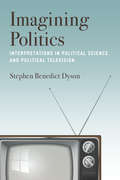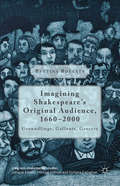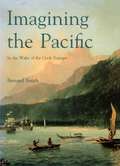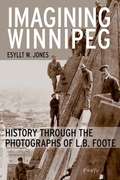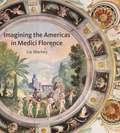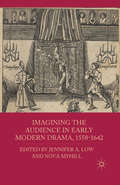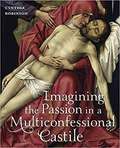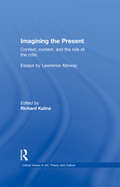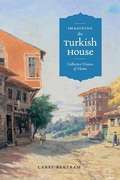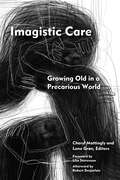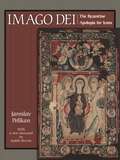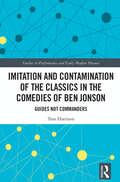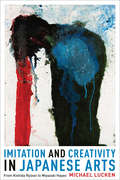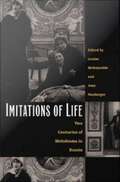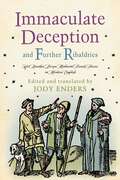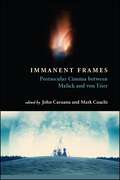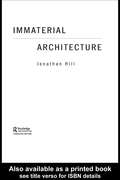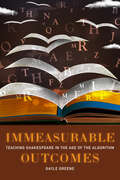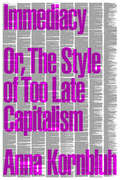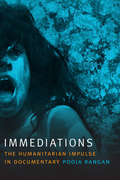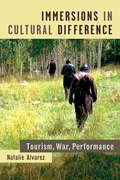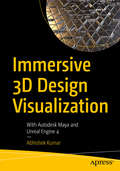- Table View
- List View
Imagining Politics: Interpretations in Political Science and Political Television
by Stephen Benedict DysonImagining Politics critically examines two interpretations of government. The first comes from pop culture fictions about politics, the second from academic political science. Stephen Benedict Dyson argues that televised political fictions and political science theories are attempts at meaning-making, reflecting and shaping how a society thinks about its politics. By taking fiction seriously, and by arguing that political science theory is homologous to fiction, the book offers a fresh perspective on both, using fictions such as The West Wing, House of Cards, Borgen, Black Mirror, and Scandal to challenge the assumptions that construct the discipline of political science itself. Imagining Politics is also about a political moment in the West. Two great political shocks—Brexit and the election of Donald Trump—are set in a new context here. Dyson traces how Brexit and Trump campaigned against our image of politics as usual, and won.
Imagining Shakespeare's Original Audience, 1660-2000: Groundlings, Gallants, Grocers (Palgrave Shakespeare Studies)
by Bettina BoeckerComparatively little is known about Shakespeare's first audiences. This study argues that the Elizabethan audience is an essential part of Shakespeare as a site of cultural meaning, and that the way criticism thinks of early modern theatregoers is directly related to the way it thinks of, and uses, the Bard himself.
Imagining The Pacific
by Bernard SmithIn this book Bernard Smith explores in more depth the issued first dealt with in his classic European Vision and the South Pacific. He continues his careful examination of how European artists and scientists travelling to the Pacific during the time of Cook's voyages were stimulated to see the world in new and creative ways. In analysing intensely personal responses to a new accessible environment, Bernard Smith shows how science, topography and travel had an impact on current pictorial genres. Among many surprising findings he argues that the obligation science placed on art to provide information was a factor in the triumph of Impressionism during the late nineteenth century. With its breadth of vision and attention to detail, its exploration of the complex relationship between the pursuit of knowledge and the exercise of power, Imagining the Pacific takes its place alongside Bernard Smith's earlier work as a milestone in historical scholarship.
Imagining Winnipeg: History through the Photographs of L.B. Foote
by Esyllt W. JonesIn an expanding and socially fractious early twentieth-century Winnipeg, Lewis Benjamin Foote (1873-1957) rose to become the city’s pre-eminent commercial photographer. Documenting everything from royal visits to deep poverty, from the building of the landmark Fort Garry Hotel to the turmoil of the 1919 General Strike, Foote’s photographs have come to be iconic representations of early Winnipeg life. They have been used to illustrate everything from academic histories to posters for rock concerts; they have influenced the work of visual artists, writers, and musicians; and they have represented Winnipeg to the nation. But in Imagining Winnipeg, historian Esyllt W. Jones takes us beyond the iconic to reveal the complex artist behind the lens and the conflicting ways in which his photographs have been used to give credence to diverse and sometimes irreconcilable views of Winnipeg’s past. Incorporating 150 stunning photographs from the more than 2,000 images in the Archives of Manitoba Foote Collection, Imagining Winnipeg challenges our understanding of visual history and the city we thought we knew.
Imagining the Americas in Medici Florence
by Lia MarkeyThe first full-length study of the impact of the discovery of the Americas on Italian Renaissance art and culture, Imagining the Americas in Medici Florence demonstrates that the Medici grand dukes of Florence were not only great patrons of artists but also early conservators of American culture.In collecting New World objects such as featherwork, codices, turquoise, and live plants and animals, the Medici grand dukes undertook a “vicarious conquest” of the Americas. As a result of their efforts, Renaissance Florence boasted one of the largest collections of objects from the New World as well as representations of the Americas in a variety of media. Through a close examination of archival sources, including inventories and Medici letters, Lia Markey uncovers the provenance, history, and meaning of goods from and images of the Americas in Medici collections, and she shows how these novelties were incorporated into the culture of the Florentine court. More than just a study of the discoveries themselves, this volume is a vivid exploration of the New World as it existed in the minds of the Medici and their contemporaries. Scholars of Italian and American art history will especially welcome and benefit from Markey’s insight.
Imagining the Americas in Medici Florence
by Lia MarkeyThe first full-length study of the impact of the discovery of the Americas on Italian Renaissance art and culture, Imagining the Americas in Medici Florence demonstrates that the Medici grand dukes of Florence were not only great patrons of artists but also early conservators of American culture.In collecting New World objects such as featherwork, codices, turquoise, and live plants and animals, the Medici grand dukes undertook a “vicarious conquest” of the Americas. As a result of their efforts, Renaissance Florence boasted one of the largest collections of objects from the New World as well as representations of the Americas in a variety of media. Through a close examination of archival sources, including inventories and Medici letters, Lia Markey uncovers the provenance, history, and meaning of goods from and images of the Americas in Medici collections, and she shows how these novelties were incorporated into the culture of the Florentine court. More than just a study of the discoveries themselves, this volume is a vivid exploration of the New World as it existed in the minds of the Medici and their contemporaries. Scholars of Italian and American art history will especially welcome and benefit from Markey’s insight.
Imagining the Audience in Early Modern Drama, 1558–1642
by Jennifer A. Low Nova MyhillThis essay collection builds on the latest research on the topic of theatre audiences in early modern England. In broad terms, the project answers the question, 'How do we define the relationships between performance and audience?'.
Imagining the Byzantine Past
by Elena N. BoeckTwo lavish, illustrated histories confronted and contested the Byzantine model of empire. The Madrid Skylitzes was created at the court of Roger II of Sicily in the mid-twelfth century. The Vatican Manasses was produced for Ivan Alexander of Bulgaria in the mid-fourteenth century. Through close analysis of how each chronicle was methodically manipulated, this study argues that Byzantine history was selectively re-imagined to suit the interests of outsiders. The Madrid Skylitzes foregrounds regicides, rebellions, and palace intrigue in order to subvert the divinely ordained image of order that Byzantine rulers preferred to project. The Vatican Manasses presents Byzantium as a platform for the accession of Ivan Alexander to the throne of the Third Rome, the last and final world-empire. Imagining the Byzantine Past demonstrates how distinct visions of empire generated diverging versions of Byzantium's past in the aftermath of the Crusades.
Imagining the Passion in a Multiconfessional Castile
by Cynthia RobinsonRecent research into the texts, practices, and visual culture of late medieval devotional life in western Europe has clearly demonstrated the centrality of devotions to Christ’s Passion. The situation in Castile, however, could not have been more different. Prior to the final decades of the fifteenth century, individual relationships to Christ established through the use of “personalized” Passion imagery simply do not appear to have been a component of Castilian devotional culture.
Imagining the Present: Context, Content, and the Role of the Critic (Critical Voices in Art, Theory and Culture)
by Lawrence AllowayBringing together twenty-nine of Lawrence Alloway’s most influential essays in one volume, this fascinating collection provides valuable perspectives on the art and visual culture of the second half of the twentieth century. Lawrence Alloway ranks among the most important critics of his time, and his contributions to the spirited and contentious dialogue of his era make for fascinating reading. These twenty-nine provocative essays from 1956 to 1980 from the man who invented the term ‘pop art’ bring art, film, iconography, cybernetics and culture together for analysis and investigation, and do indeed examine the context, content and role of the critic in art and visual culture. Featuring a critical commentary by Richard Kalina, and preface by series editor Saul Ostrow, Imagining the Present will be an enthralling read for all art and visual culture students.
Imagining the Turkish House: Collective Visions of Home
by Carel Bertram"Houses can become poetic expressions of longing for a lost past, voices of a lived present, and dreams of an ideal future." <P><P>Carel Bertram discovered this truth when she went to Turkey in the 1990s and began asking people about their memories of "the Turkish house." The fondness and nostalgia with which people recalled the distinctive wooden houses that were once ubiquitous throughout the Ottoman Empire made her realize that "the Turkish house" carries rich symbolic meaning. In this delightfully readable book, Bertram considers representations of the Turkish house in literature, art, and architecture to understand why the idea of the house has become such a potent signifier of Turkish identity.
Imagistic Care: Growing Old in a Precarious World (Thinking from Elsewhere)
by Cheryl MattinglyImagistic Care explores ethnographically how images function in our concepts, our writing, our fieldwork, and our lives. With contributions from anthropologists, philosophers and an artist, the volume asks: How can imagistic inquiries help us understand the complex entanglements of self and other, dependence and independency, frailty and charisma, notions of good and bad aging, and norms and practices of care in old age? And how can imagistic inquiries offer grounds for critique? Cutting between ethnography, phenomenology and art, this volume offers a powerful contribution to understandings of growing old. The images created in words and drawings are used to complicate rather than simplify the world. The contributors advance an understanding of care, and of aging itself, marked by alterity, spectral presences and uncertainty.Contributors: Rasmus Dyring, Harmandeep Kaur Gill, Lone Grøn, Maria Louw, Cheryl Mattingly, Lotte Meinert, Maria Speyer, Helle S. Wentzer, Susan Reynolds Whyte
Imago Dei: The Byzantine Apologia for Icons (The A. W. Mellon Lectures in the Fine Arts #36)
by Jaroslav PelikanA sweeping account of the controversies surrounding the worship of images in the early Byzantine churchIn 726, the Byzantine emperor, Leo III, issued an edict that all religious images in the empire were to be destroyed, a directive that was later endorsed by a synod of the church in 753 under his son, Constantine V. If the policy of Iconoclasm had succeeded, the entire history of Christian art—and of the Christian church, at least in the East—would have been altered.Iconoclasm was defeated by Byzantine politics, popular revolts, monastic piety, and, most fundamentally of all, by theology, just as it had been theology that the opponents of images had used to justify their actions. Analyzing an intriguing chapter in the history of ideas, the renowned scholar Jaroslav Pelikan shows how a faith that began by attacking the worship of images ended first in permitting and then in commanding it.Pelikan charts the theological defense of icons during the iconoclastic controversies of the eighth and ninth centuries, whose high point came in 787, when the Second Council of Nicaea restored the cult of images in the church. He demonstrates how the dogmas of the Trinity and the Incarnation eventually provided the basic rationale for images: because the invisible God had become human and therefore personally visible in Jesus Christ, it became permissible to make images of that Image. And because not only the human nature of Christ, but that of his Mother had been transformed by the Incarnation, she, too, could be “iconized,” together with all the other saints and angels.The iconographic “text” of the book is provided by one of the very few surviving icons from the period before Iconoclasm, the Egyptian tapestry Icon of the Virgin now in the Cleveland Museum of Art. Other icons serve to illustrate the theological argument, just as the theological argument serves to explain the icons.In an incisive foreword, Judith Herrin explains the enduring importance of the book and discusses how later scholars have built on Pelikan’s work.Please note: All images in this ebook are presented in black and white and have been reduced in size.
Imitation and Contamination of the Classics in the Comedies of Ben Jonson: Guides Not Commanders (Studies in Performance and Early Modern Drama)
by Tom HarrisonThis book focuses on the influence of classical authors on Ben Jonson’s dramaturgy, with particular emphasis on the Greek and Roman playwrights and satirists. This book illuminates the interdependence of the aspects of Jonson’s creative personality by considering how classical performance elements including the Aristophanic ‘Great Idea,’ chorus, Terentian/Plautine performative strategies, and ‘performative’ elements from literary satire manifest themselves in the structuring and staging of his plays. This fascinating exploration contributes to the ‘performative turn’ in early modern studies by reframing Jonson’s classicism as essential to his dramaturgy as well as his erudition. This book is also a case study for how the early modern education system’s emphasis on imitative-contaminative practices prepared its students, many of whom became professional playwrights, for writing for a theatre that had a similar emphasis on the recycling and recombining performative tropes and structures.
Imitation and Creativity in Japanese Arts: From Kishida Ryusei to Miyazaki Hayao
by Michael Lucken Francesca SimkinThe idea that Japanese art is produced through rote copy and imitation is an eighteenth-century colonial construction, with roots in Romantic ideals of originality. Offering a much-needed corrective to this critique, Michael Lucken demonstrates the distinct character of Japanese mimesis and its dynamic impact on global culture, showing through several twentieth-century masterpieces the generative and regenerative power of Japanese creativity. Choosing a representative work from each of four modern genres-painting, film, photography, and animation-Lucken portrays the range of strategies that Japanese artists use to re-present contemporary influences. He examines Kishida Ryusei's portraits of Reiko (1914-1929), Kurosawa Akira's Ikiru (1952), Araki Nobuyoshi's photographic novel Sentimental Journey-Winter (1991), and Miyazaki Hayao's popular anime film Spirited Away (2001), revealing the sophisticated patterns of mimesis that are unique but not exclusive to modern Japanese art. In doing so, Lucken identifies the tensions that drive the Japanese imagination, which are much richer than a simple opposition between progress and tradition, and their reflection of human culture's universal encounter with change. This global perspective explains why, despite its non-Western origins, Japanese art has earned such a vast following.
Imitation and Creativity in Japanese Arts: From Kishida Ryusei to Miyazaki Hayao (Asia Perspectives: History, Society, and Culture)
by Michael LuckenThe idea that Japanese art is produced through rote copy and imitation is an eighteenth-century colonial construct, with roots in Romantic ideals of originality. Offering a much-needed corrective to this critique, Michael Lucken demonstrates the distinct character of Japanese mimesis and its dynamic impact on global culture, showing through several twentieth-century masterpieces the generative and regenerative power of Japanese arts.Choosing a representative work from each of four modern genres—painting, film, photography, and animation—Lucken portrays the range of strategies that Japanese artists use to re-present contemporary influences. He examines Kishida Ryusei's portraits of Reiko (1914–1929), Kurosawa Akira's Ikiru (1952), Araki Nobuyoshi's photographic novel Sentimental Journey—Winter (1991), and Miyazaki Hayao's popular anime film Spirited Away (2001), revealing the sophisticated patterns of mimesis that are unique but not exclusive to modern Japanese art. In doing so, Lucken identifies the tensions that drive the Japanese imagination, which are much richer than a simple opposition between progress and tradition, and their reflection of human culture's universal encounter with change. This global perspective explains why, despite its non-Western origins, Japanese art has earned such a vast following.
Imitations of Life: Two Centuries of Melodrama in Russia
by Louise Mcreynolds Joan NeubergerImitations of Life views Russian melodrama from the eighteenth century to today as an unexpectedly hospitable forum for considering social issues. The contributors follow the evolution of the genre through a variety of cultural practices and changing political scenarios. They argue that Russian audiences have found a particular type of comfort in this mode of entertainment that invites them to respond emotionally rather than politically to social turmoil. Drawing on a wide variety of sources, including plays, lachrymose novels, popular movies, and even highly publicized funerals and political trials, the essays in Imitations of Life argue that melodrama has consistently offered models of behavior for times of transition, and that contemporary televised versions of melodrama continue to help Russians cope with national events that they understand implicitly but are not yet able to articulate. In contrast to previous studies, this collection argues for a reading that takes into account the subtle but pointed challenges to national politics and to gender and class hierarchies made in melodramatic works from both the nineteenth and twentieth centuries. Collectively, the contributors shift and cross borders, illustrating how the cultural dismissal of melodrama as fundamentally escapist and targeted primarily at the politically disenfranchised has subverted the drama's own intrinsically subversive virtues. Imitations of Life will interest students and scholars of contemporary Russia, and Russian history, literature, and theater. Contributors. Otto Boele, Julie Buckler, Julie Cassiday, Susan Costanzo, Helena Goscilo, Beth Holmgren, Lars Lih, Louise McReynolds, Joan Neuberger, Alexander Prokhorov, Richard Stites
Immaculate Deception and Further Ribaldries: Yet Another Dozen Medieval French Farces in Modern English (The Middle Ages Series)
by Jody EndersDid you hear the one about the Mother Superior who was so busy casting the first stone that she got caught in flagrante delicto with her lover? What about the drunk with a Savior complex who was fool enough to believe himself to be the Second Coming? And that's nothing compared to what happens when comedy gets its grubby paws on the confessional. Enter fifteenth- and sixteenth-century French farce, the "bestseller" of a world that stands to tell us a lot about the enduring influence of a Shakespeare or a Molière. It's the sacrilegious world of Immaculate Deception, the third volume in a series of stage-friendly translations from the Middle French. Brought to you through the wonders of Open Access, these twelve engagingly funny satires target religious hypocrisy in that in-your-face way that only true slapstick can muster. There is literally nothing sacred.Why this repertoire and why now? The current political climate has had dire consequences for the pleasures of satire at a cultural moment when we have never needed it more. It turns out that the proverbial Dark Ages had a lighter side; and France's over 200 rollicking, frolicking, singing, and dancing comedies—more extant than in any other vernacular—have waited long enough for their moment in the spotlight. They are seriously funny: funny enough to reclaim their place in cultural history, and serious enough to participate in the larger conversation about what it means to be a social influencer, then and now. Rather than relegate medieval texts to the dustbin of history, an unabashedly feminist translation can reframe and reject the sexism of bygone days by doing what theater always invites us to do: interpret, inflect, and adapt.
Immanent Frames: Postsecular Cinema between Malick and von Trier (SUNY series, Horizons of Cinema)
by John Caruana; Mark CauchiFor some time now, thinkers across the humanities and social sciences have increasingly called into question the once-dominant view of the relationship between modernity and secularism, prompting some to speak of a "postsecular turn." Until now, film studies has largely been silent about this development, even though cinema itself has been a major vehicle for such reflection. This fact became inescapable in 2011 when Terrence Malick's The Tree of Life and Lars von Trier's Melancholia were released within days of each other. While these two audacious and controversial films present seemingly opposite perspectives—the former a thoughtful meditation on faith, the latter a portrayal of nontriumphalist atheism—together they raise critical questions about transcendence and immanence in modern life. These films are, however, only the most conspicuous of a growing body of works that call forth similar and related questions—what this collection aptly calls "postsecular cinema."Taking the nearly simultaneous release of The Tree of Life and Melancholia as its starting point and framing device, this pioneering collection sets out to establish the idea of postsecular cinema as a distinct body of films and a viable critical category. Adopting a film-philosophy approach, one group of essays examines Malick's and von Trier's films, while another looks at works by Chantal Akerman, Denys Arcand, the Dardenne brothers, and John Michael McDonagh, among others. The volume closes with two important interviews with Luc Dardenne and Jean-Luc Nancy that invite us to reflect more deeply on some of the central concerns of postsecular cinema.
Immaterial Architecture
by Jonathan HillThis fascinating argument from Jonathan Hill presents the case for the significance and importance of the immaterial in architecture. Architecture is generally perceived as the solid, physical matter that it unarguably creates, but what of the spaces it creates? This issue drives Hill's explorative look at the immaterial aspects of architecture. The book discusses the pressures on architecture and the architectural profession to be respectively solid matter and solid practice and considers concepts that align architecture with the immaterial, such as the superiority of ideas over matter, command of drawing and design of spaces and surfaces. Focusing on immaterial architecture as the perceived absence of matter, Hill devises new means to explore the creativity of both the user and the architect, advocating an architecture that fuses the immaterial and the material and considers its consequences, challenging preconceptions about architecture, its practice, purpose, matter and use. This is a useful and innovative read that encourages architects and students to think beyond established theory and practice.
Immeasurable Outcomes: Teaching Shakespeare in the Age of the Algorithm
by Gayle GreeneWhat is the purpose of education? The answer might be found in a Shakespeare class at a small liberal arts college.In this engaging account of teaching a Shakespeare class at a small liberal arts college, Gayle Greene illustrates what is so vital and urgent about the humanities. Follow along with Greene as she introduces us to her students and showcases their strengths, needs, and vulnerabilities, so we can experience the magic of her classroom. In Immeasurable Outcomes, Greene's class builds a complex human ecosystem that pushes students to think more deeply and discover their own interests and potential, all while recognizing the inherent dignity in other people's views and values. Grounding her analyses in half a century of teaching, Greene pushes back against the demand for measurable student learning outcomes and the standardization imposed on K-12 schools in the name of reform. Instead, she draws her conclusions about education directly from the students themselves. Alumni testimonials describe the transformative power of a liberal arts education, recounting how their experience of community and engagement has provided them the tools to navigate the uncertainties of a rapidly changing world while also inspiring the social awareness our democracy depends on. Immeasurable Outcomes rejects claims that the liberal arts are impractical, exposing the political agendas of technocrats and ideologues who would transform higher education into vocational training and programs focused only on profitability. Greene reminds us that the liberal arts have been the basis for the most successful educational system in the world and provides a powerful demonstration that education at a human scale that is relationship-rich and humanities-based should be the model for education in the future.
Immediacy: Or, The Style of Too Late Capitalism
by Anna KornbluhWhy speed, flow, and direct expression now dominate cultural styleContemporary cultural style boosts transparency and instantaneity. These are values absorbed from our current economic conditions of "disintermediation": cutting out the middleman. Like Uber, but for art. Immediacy names this style to make sense of what we lose when the contradictions of twenty-first-century capitalism demand that aesthetics negate mediation. Surging realness as an aesthetic program synchs with the economic imperative to intensify circulation when production stagnates. "Flow" is the ultimate twenty-first-century buzzword, but speedy circulation grinds art down to the nub. And the bad news is that political turmoil and social challenges require more mediation. Collective will, inspiring ideas, and deliberate construction are the only way out, but our dominant style forgoes them. Considering original streaming TV, popular literature, artworld trends, and academic theories, Immediacy explains the recent obsession with immersion and today&’s intolerance of representation, and points to alternative forms in photography, TV, novels, and constructive theory that prioritize distance, impersonality, and big ideas instead.
Immediations: The Humanitarian Impulse in Documentary
by Pooja RanganEndangered life is often used to justify humanitarian media intervention, but what if suffering humanity is both the fuel and outcome of such media representations? Pooja Rangan argues that this vicious circle is the result of immediation, a prevailing documentary ethos that seeks to render human suffering urgent and immediate at all costs. Rangan interrogates this ethos in films seeking to “give a voice to the voiceless,” an established method of validating the humanity of marginalized subjects, including children, refugees, autistics, and animals. She focuses on multiple examples of documentary subjects being invited to demonstrate their humanity: photography workshops for the children of sex workers in Calcutta; live eyewitness reporting by Hurricane Katrina survivors; attempts to facilitate speech in nonverbal autistics; and painting lessons for elephants. These subjects are obliged to represent themselves using immediations—tropes that reinforce their status as the “other” and reproduce definitions of the human that exclude non-normative modes of thinking, being, and doing. To counter these effects, Rangan calls for an approach to media that aims not to humanize but to realize the full, radical potential of giving the camera to the other.
Immersions in Cultural Difference: Tourism, War, Performance
by Natalie AlvarezIn a time of intensifying xenophobia and anti-immigration measures, this book examines the impulse to acquire a deeper understanding of cultural others. Immersions in Cultural Difference takes readers into the heart of immersive simulations, including a simulated terrorist training camp in Utah; mock Afghan villages at military bases in Canada and the UK; a fictional Mexico-US border run in Hidalgo, Mexico; and an immersive tour for settlers at a First Nations reserve in Manitoba, Canada. Natalie Alvarez positions the phenomenon of immersive simulations within intersecting cultural formations: a neoliberal capitalist interest in the so-called “experience economy” that operates alongside histories of colonization and a heightened state of xenophobia produced by War on Terror discourse. The author queries the ethical stakes of these encounters, including her own in relation to the field research she undertakes. As the book moves from site to site, the reader discovers how these immersions function as intercultural rehearsal theaters that serve a diverse set of strategies and pedagogical purposes: they become a “force multiplier” within military strategy, a transgressive form of dark tourism, an activist strategy, and a global, profit-generating practice for a neoliberal capitalist marketplace.
Immersive 3D Design Visualization: With Autodesk Maya and Unreal Engine 4
by Abhishek KumarDiscover the methods and techniques required for creating immersive design visualization for industry. This book proposes ways for industry-oriented design visualization from scratch. This includes fundamentals of creative and immersive technology; tools and techniques for architectural visualization; design visualization with Autodesk Maya; PBR integration; and texturing, material design, and integration into UE4 for immersive design visualization. You’ll to dive into design and visualization, from planning to execution. You will start with the basics, such as an introduction to design visualization as well as to the software you will be using. You will next learn to create assets such as virtual worlds and texturing, and integrate them with Unreal Engine 4. Finally, there is a capstone project for you to make your own immersive visualization scene. By the end of the book you’ll be able to create assets for use in industries such as game development, entertainment, architecture, design engineering, and digital education. What You Will Learn Gain the fundamentals of immersive design visualization Master design visualization with Autodesk Maya Study interactive visualization with UE4 Create your immersive design portfolio Who This Book Is For Beginning-intermediate learners from the fields of animation, visual art, and computer graphics as well as design visualization, game technology, and virtual reality integration.
